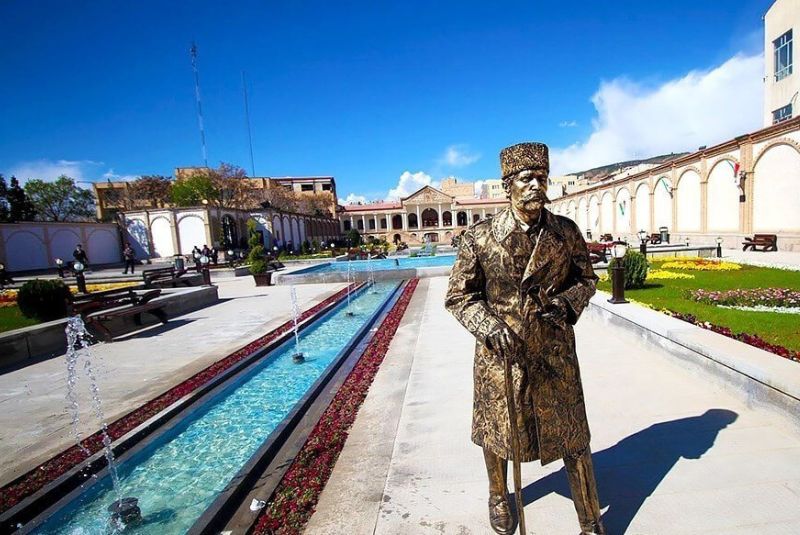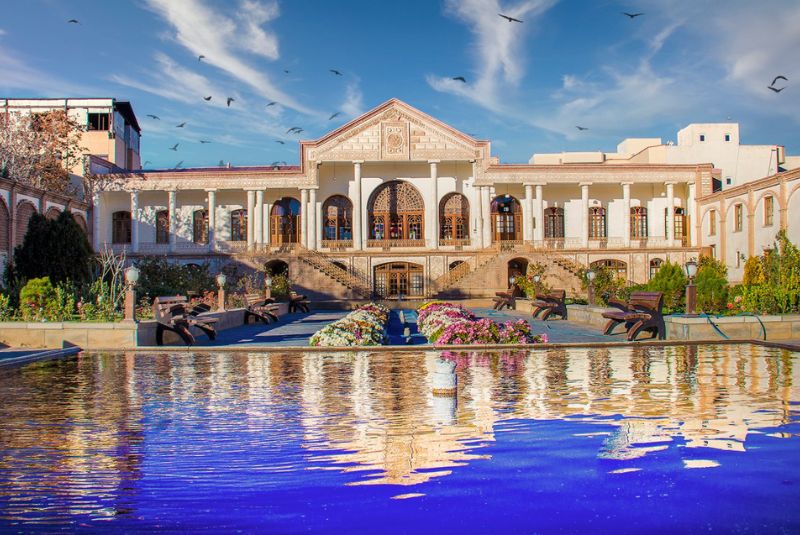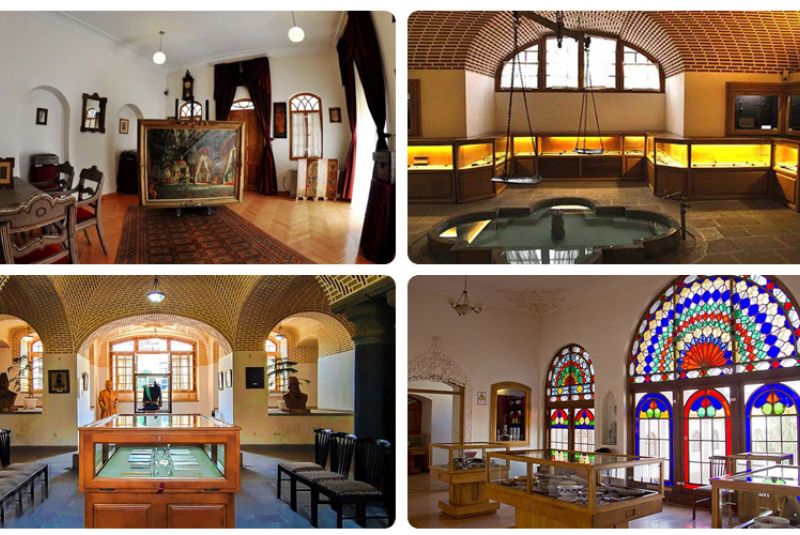Qajar Museum in Tabriz | A Complete Visitor’s Guide
The Qajar Museum in Tabriz stands out as a must-visit attraction for those who are fascinated by Iranian history and architecture.
Tabriz, one of Iran's oldest cities, is known for its rich history, art, and cultural heritage. As a major center for trade and civilization, Tabriz has witnessed many historical events and has preserved its significance throughout the centuries. Among its numerous attractions, the Qajar Museum in Tabriz stands out as a must-visit for those who are fascinated by Iranian history and architecture.
Housed in the beautiful Amir Nezam House, a mansion built during the Qajar dynasty, this museum offers a glimpse into the daily life, art, and culture of that era. The House of Amir Nezam Garrousi, located in the historic Sheshghelan neighborhood, has been carefully preserved to showcase the grandeur of Qajar-era architecture. Through its unique exhibits and stunning design, the museum opens a window into the past, allowing visitors to explore one of Iran's most important historical periods.
If you're considering travelling to Tabriz, you should include this museum in your visit-list.
History of the Qajar Museum & Amir Nezam House

The house of AmirNezam Garrousi, a beautiful example of Qajar-era architecture, was built in the 19th century during the reign of Naser al-Din Shah Qajar. Located in Tabriz's historic Sheshghelan neighborhood, the mansion was initially constructed as the residence of Amir Nezam Garrousi, a prominent statesman and diplomat. The house is known for its traditional Persian architectural elements, including symmetrical design, elegant arches, large courtyards, and stained glass windows. Its two-story structure is adorned with intricate plasterwork, wooden columns, and decorative mirrorwork that reflects the luxurious lifestyle of the Qajar nobility.
In 1993, this historic mansion was transformed into the Qajar Museum to preserve and showcase the history of the Qajar dynasty. After extensive renovations, the museum officially opened in 2006, turning the House of Amir Nezam Garrousi into a cultural treasure for locals and tourists alike. The museum's collection includes artifacts from the Qajar era, including fine art, weapons, coins, clothing, and everyday objects.
Amir Nezam Garrousi played a significant role in Iranian politics during the 19th century, serving as a diplomat and governor in various regions. His influence and leadership during the Qajar period are remembered through this museum, which now stands as a testament to his legacy and the rich history of the Qajar era in Iran.
| Suggestion: Tabriz Music Museum
Architectural Features of the Qajar Museum

The Qajar Museum in Tabriz is a stunning example of Persian architectural elegance from the Qajar era. The mansion’s exterior reflects the grandeur of traditional Iranian design. Its façade is adorned with intricate brickwork, featuring delicate patterns that display the craftsmanship of the period. The mansion is surrounded by a beautiful garden, known as a "bagh," typical of Persian homes, with tall trees, manicured flower beds, and fountains that enhance the sense of tranquility and luxury. The house's symmetrical design and large wooden doors further reflect the architectural traditions of the Qajar dynasty.
Inside, the mansion is equally impressive, featuring unique and elaborate details. The stained glass windows—with their vibrant reds, blues, and greens—create a kaleidoscope of colors as sunlight pours into the rooms. The plasterwork throughout the mansion is finely detailed, showcasing floral patterns and geometric designs. Mirrorwork, often used in Persian homes, reflects light across the interior, adding a sense of opulence. The traditional Persian décor further complements the house’s historical charm, with handcrafted carpets and antique furniture that harken back to the Qajar period.
Notable rooms in the mansion include the grand reception halls, where dignitaries and guests were once welcomed. The central courtyard, surrounded by large arched windows, provides an open space for relaxation and social gatherings. Several rooms now serve as exhibition halls, displaying key artifacts from the Qajar period, such as weapons, coins, and artwork. These rooms give visitors a deeper understanding of life during the Qajar era, making the museum not just a historical monument, but a rich cultural experience.
| Suggestion: Tabriz Bazaar Complex
Exhibits and Collections

The Qajar Museum in Tabriz offers visitors a captivating collection of artifacts from the Qajar dynasty (1789–1925). The museum’s exhibits span a variety of categories, giving visitors a comprehensive look into the culture, politics, and daily life of the Qajar era. From fine art to historical documents, the museum houses valuable treasures that highlight the legacy of this important period in Iranian history. Visitors can explore rooms filled with jewelry, costumes, weaponry, coins, stamps, and artwork, all thoughtfully curated to offer insights into the Qajar lifestyle.
One of the notable exhibits is the Qajar Era Jewelry collection. These ornate pieces are adorned with intricate designs, often encrusted with precious gems like emeralds, rubies, and diamonds. The jewelry on display reflects the wealth and sophistication of the Qajar court, with each piece showcasing expert craftsmanship.
The museum also features an impressive display of traditional Qajar costumes and attire. These garments, often made from fine silks and embroidered with gold and silver thread, represent the luxurious fashion of the time. The rich patterns and colors in the clothing give visitors a glimpse into the opulence of Qajar-era fashion.
Weaponry is another fascinating aspect of the collection, with an array of swords, shields, and guns on display. These military artifacts highlight the Qajar dynasty's approach to warfare and defense, emphasizing the role of craftsmanship in creating both functional and decorative weapons.

The coins and stamps collection showcases the economic aspects of the Qajar period, illustrating how trade and commerce flourished during this time. The intricate designs of the coins and stamps reflect the artistic influences of the era, while also shedding light on the economic history of Iran.
Additionally, visitors can marvel at the museum’s collection of art and calligraphy, featuring finely detailed miniatures and beautiful Persian script. These pieces demonstrate the high level of artistic achievement during the Qajar era, with a focus on portraiture, nature, and poetry.
The museum's layout enhances the visitor experience by grouping related exhibits together, allowing for an easy flow from one area to the next. This thoughtful arrangement not only provides a chronological journey through Qajar history but also allows visitors to fully immerse themselves in the art, culture, and politics of the time.
| Discover: Persian Art
Tabriz Qajar Museum Location and Access
The Qajar Museum in Tabriz is located in the historic Amir Nezam House in the Sheshghelan neighborhood, one of the oldest districts of the city. The museum’s exact address is accessible via local transport, with taxis and buses running frequently from key locations in Tabriz. Nearby landmarks include the Tabriz Bazaar and the Blue Mosque, making it easy to include the museum as part of a day’s sightseeing.
The museum is typically open from 9:00 AM to 5:00 PM daily, with extended hours in summer. Entry fees are modest, usually around 200,000 IRR for foreign visitors, while locals and students may enjoy discounts. It is best to check local sources for updated ticket prices before visiting.
Facilities at the museum include restrooms and a small gift shop. Limited parking is available nearby, and the museum is partially accessible for disabled visitors, though some areas may be challenging due to the mansion’s historic layout.
To make the most of your visit, plan to spend at least 1-2 hours exploring the museum. The best time to visit is early in the morning when the museum is quieter. Visitors should bring comfortable shoes for walking around the mansion and its garden, and don’t forget to bring a camera to capture the beautiful architecture and exhibits.
| Suggestion: Top 23 Museums in Iran + Photos
Nearby Attractions in Tabriz

In addition to the Qajar Museum, Tabriz is home to several other must-see attractions that highlight the city’s rich history and culture.
- Blue Mosque (Masjed-e Kabud): Built in the 15th century, this iconic mosque is known for its stunning blue tiles, intricate calligraphy, and elegant architecture. Though partially damaged by an earthquake, its beauty and historical significance remain undeniable, making it one of Tabriz's top landmarks.
- Tabriz Bazaar (UNESCO World Heritage Site): The Tabriz Grand Bazaar is one of the oldest and largest covered bazaars in the world. This sprawling marketplace has been a hub of trade and commerce for centuries, offering visitors a vibrant experience of traditional Iranian culture, with shops selling everything from spices to carpets.
- El Goli Park (Shah Goli): Once a royal retreat, this beautiful park features a large central pool and lush green surroundings. The park is a popular spot for both locals and tourists, offering a peaceful environment to relax or take a boat ride on the pool.
- Azerbaijan Museum: Located near the Blue Mosque, this museum showcases archaeological artifacts from ancient civilizations, as well as artworks from different periods of Iranian history, giving visitors a deep dive into the country’s cultural heritage.
- Constitution House of Tabriz (Khaneh Mashrouteh): This historic house played a key role during the Iranian Constitutional Revolution (1905–1911). Visitors can explore its beautifully preserved rooms, which display documents and photographs from the revolutionary era.
- Arg-e Tabriz (Tabriz Citadel): Dating back to the Ilkhanate period, this massive fortress has stood as a symbol of Tabriz’s historical resilience. Though largely in ruins, the citadel remains a significant part of the city’s architectural heritage.
Final Takeaway
The Qajar Museum in Tabriz is a must-visit destination for anyone interested in Iranian history and culture. Housed in the majestic Amir Nezam House, the museum provides a deep look into the Qajar dynasty, while its stunning architecture and rich collection of artifacts make it a highlight of any trip to Tabriz.
Don’t miss the opportunity to explore the nearby attractions, from the Blue Mosque to the Tabriz Bazaar, which offer a full experience of the city’s heritage. A visit to Tabriz is not complete without soaking in its historic and cultural richness.
Share your story!
Comment below and let us know about your Experience.
Your story inspires others!


Comment
Leave a Comment